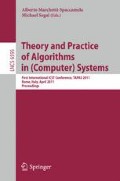Abstract
A particularly important emergent technology is heterogeneous processors (or cores), which many computer architects believe will be the dominant architectural design in the future. The main advantage of a heterogeneous architecture, relative to an architecture of identical processors, is that it allows for the inclusion of processors whose design is specialized for particular types of jobs, and for jobs to be assigned to a processor best suited for that job. Most notably, it is envisioned that these heterogeneous architectures will consist of a small number of high-power high-performance processors for critical jobs, and a larger number of lower-power lower-performance processors for less critical jobs. Naturally, the lower-power processors would be more energy efficient in terms of the computation performed per unit of energy expended, and would generate less heat per unit of computation. For a given area and power budget, heterogeneous designs can give significantly better performance for standard workloads. Moreover, even processors that were designed to be homogeneous, are increasingly likely to be heterogeneous at run time: the dominant underlying cause is the increasing variability in the fabrication process as the feature size is scaled down (although run time faults will also play a role). Since manufacturing yields would be unacceptably low if every processor/core was required to be perfect, and since there would be significant performance loss from derating the entire chip to the functioning of the least functional processor (which is what would be required in order to attain processor homogeneity), some processor heterogeneity seems inevitable in chips with many processors/cores.
Access this chapter
Tax calculation will be finalised at checkout
Purchases are for personal use only
References
Edmonds, J., Pruhs, K.: Scalably scheduling processes with arbitrary speedup curves. In: ACM-SIAM Symposium on Discrete Algorithms, pp. 685–692 (2009)
Gupta, A., Krishnaswamy, R., Pruhs, K.: Nonclairvoyantly scheduling power-heterogeneous processors. In: IEEE International Green Computing Conference (2010)
Gupta, A., Krishnaswamy, R., Pruhs, K.: Scalably scheduling power-heterogeneous processors. In: Abramsky, S., Gavoille, C., Kirchner, C., Meyer auf der Heide, F., Spirakis, P.G. (eds.) ICALP 2010. LNCS, vol. 6198, pp. 312–323. Springer, Heidelberg (2010)
Author information
Authors and Affiliations
Editor information
Editors and Affiliations
Rights and permissions
Copyright information
© 2011 Springer-Verlag Berlin Heidelberg
About this paper
Cite this paper
Pruhs, K. (2011). Managing Power Heterogeneity. In: Marchetti-Spaccamela, A., Segal, M. (eds) Theory and Practice of Algorithms in (Computer) Systems. TAPAS 2011. Lecture Notes in Computer Science, vol 6595. Springer, Berlin, Heidelberg. https://doi.org/10.1007/978-3-642-19754-3_2
Download citation
DOI: https://doi.org/10.1007/978-3-642-19754-3_2
Publisher Name: Springer, Berlin, Heidelberg
Print ISBN: 978-3-642-19753-6
Online ISBN: 978-3-642-19754-3
eBook Packages: Computer ScienceComputer Science (R0)

